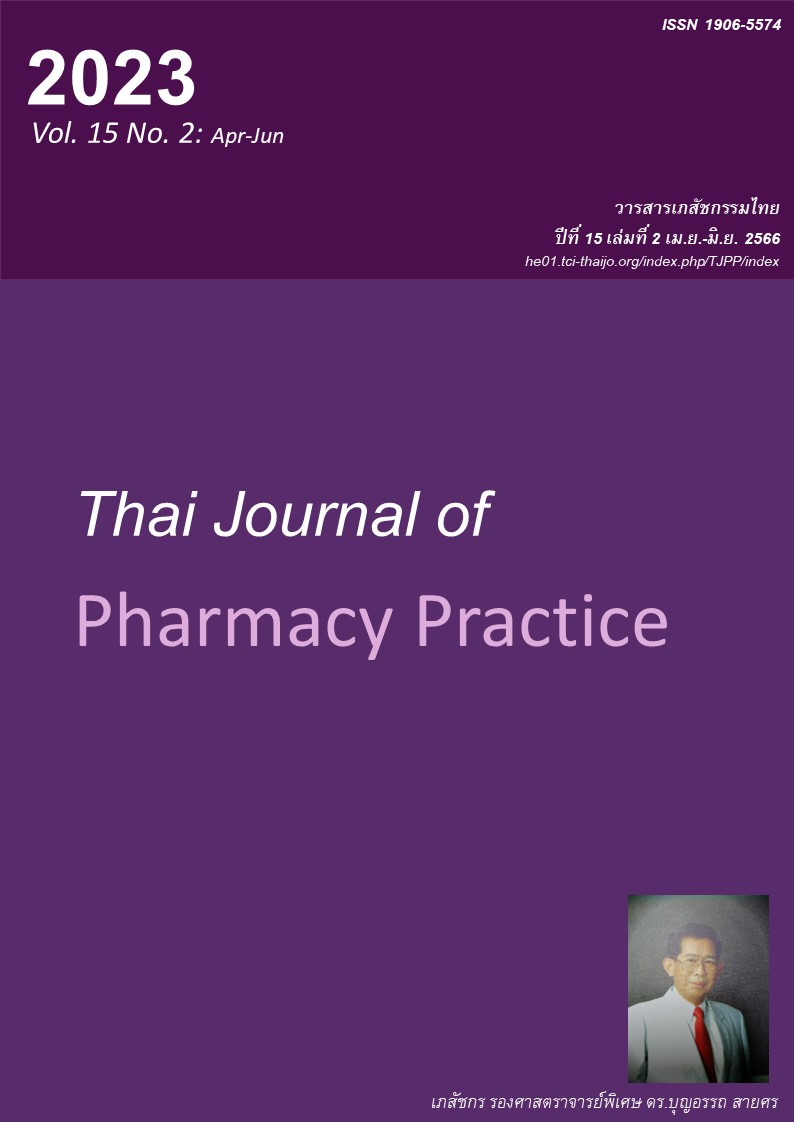ความรู้และพฤติกรรมการย้อมผมของนักศึกษามหาวิทยาลัยราชภัฏมหาสารคาม
Main Article Content
บทคัดย่อ
วัตถุประสงค์: เพื่อสำรวจความรู้เกี่ยวกับเส้นผมและผลิตภัณฑ์ย้อมผม (ความรู้ฯ) และพฤติกรรมการย้อมผม และอาการไม่พึงประสงค์ที่เกิดจากการใช้ผลิตภัณฑ์ย้อมผมของนักศึกษามหาวิทยาลัยราชภัฏมหาสารคาม และเพื่อศึกษาปัจจัยที่มีผลต่อความรู้และพฤติกรรมการใช้ผลิตภัณฑ์ย้อมผม วิธีการ: การวิจัยเชิงสำรวจครั้งนี้เก็บข้อมูลด้วยแบบสอบถามผ่านระบบออนไลน์ ตัวอย่างคือ นักศึกษามหาวิทยาลัยราชภัฏมหาสารคามจำนวน 415 คน การเลือกตัวอย่างใช้วิธีการสุ่มแบบบังเอิญในช่วงเดือนพฤศจิกายน –ธันวาคม พ.ศ. 2564 ผลการวิจัย: ตัวอย่างได้คะแนนเฉลี่ยความรู้เกี่ยวกับผลิตภัณฑ์ย้อมผม 7.64 ± 3.11 คะแนนจากคะแนนเต็ม 15 ข้อที่ตอบถูกน้อย คือ สารพาราฟีนีลีนไดอะมีนควรมีอยู่ในผลิตภัณฑ์ย้อมผมไม่เกินร้อยละ 2 (ตอบถูกร้อยละ 42.2) เหตุผลส่วนใหญ่ในการย้อมผม คือ เพื่อความสวยงาม สีน้ำตาลเป็นสีที่นิยมใช้ที่สุด สีผมที่ต้องการเป็นเหตุผลในการเลือกซื้อมากที่สุด พฤติกรรมที่ส่วนใหญ่ไม่ปฏิบัติตามคำแนะนำของผลิตภัณฑ์ คือ การทิ้งระยะเวลาที่ให้สารเคมีสัมผัสกับเส้นผมตามคำแนะนำของผลิตภัณฑ์กำหนด (ร้อยละ 68.9) อาการไม่พึงประสงค์ที่พบส่วนใหญ่ คือ ผมร่วง (ร้อยละ 52.2) ส่วนใหญ่ไม่ได้ทำการรักษา (ร้อยละ 54.4) หลังจากหายจากอาการไม่พึงประสงค์แล้ว ตัวอย่างกลับมาย้อมและไม่กลับมาย้อมในจำนวนที่ใกล้เคียงกัน (ร้อยละ 48.9 และ 51.1 ตามลำดับ) เพศหญิงมีความรู้ฯ มากกว่าเพศชายและมีพฤติกรรมการใช้ผลิตภัณฑ์ย้อมผมเหมาะสมมากกว่าอย่างมีนัยสำคัญทางสถิติ (P<0.001 ทั้งสองตัวแปร) ความรู้ฯ มีความสัมพันธ์กับพฤติกรรมการใช้ผลิตภัณฑ์ย้อมผมที่เหมาะสมอย่างมีนัยสำคัญทางสถิติ (P<0.001) สรุป: กลุ่มตัวอย่างส่วนใหญ่ยังมีความรู้และพฤติกรรมที่ไม่เหมาะสมเกี่ยวกับการย้อมผม และยังใช้ผลิตภัณฑ์ย้อมผมแม้ว่าจะเกิดอาการไม่พึงประสงค์ ส่งผลต่อความปลอดภัยในการใช้ผลิตภัณฑ์ย้อมผม
Article Details

อนุญาตภายใต้เงื่อนไข Creative Commons Attribution-NonCommercial-NoDerivatives 4.0 International License.
ผลการวิจัยและความคิดเห็นที่ปรากฏในบทความถือเป็นความคิดเห็นและอยู่ในความรับผิดชอบของผู้นิพนธ์ มิใช่ความเห็นหรือความรับผิดชอบของกองบรรณาธิการ หรือคณะเภสัชศาสตร์ มหาวิทยาลัยสงขลานครินทร์ ทั้งนี้ไม่รวมความผิดพลาดอันเกิดจากการพิมพ์ บทความที่ได้รับการเผยแพร่โดยวารสารเภสัชกรรมไทยถือเป็นสิทธิ์ของวารสารฯ
เอกสารอ้างอิง
Patzer GL. improving self-esteem by improving physi cal attractiveness. J Esthet Restor Dent 1997; 9: 44-6.
Beresniak A. Assessing the hair colorings’ impact on quality of life. J Cosmo Trichol 2015; 1: 1-6.
Khuntinanon P, Sunthorntham P, Srichard S. A follow-up study of adverse effect on cosmetic use. Thai Food and Drug Journal. 2022; 9: 29-35.
Durán B, Romero-Pérez D, Salvador J. Allergic contact dermatitis due to paraphenylenediamine: An update. Actas Dermosifiliogr 2018; 109: 602-9.
Eberle C, Sandler D, Taylor K. White A. Hair dye and chemical straightener use and breast cancer risk in a large US population of black and white women. Int J Cancer 2020; 147: 383-91.
Sudtim K, Chaijinda K, Wongratanachai A. A survey of hair dye products in beauty salon that comply with law. Thai Food and Drug Journal. 2015; 26: 51-60.
Gupta M. A study of knowledge, attitude and practices regarding hair dye use among general population. Dermatol Online J 2018; 9: 15-8
Kim J, Jung H, Kang H. A survey of the awareness, knowledge and behavior of hair dye use in a Korean population with gray hair. Ann Dermatol 2012; 24: 274-9.
Puziaawati IN. Relationship of hair health knowledge with hair care behavior post-hair dye (case study of adolescent women in Bojong Village, Pamagersari Village, Bogor Regency). Jurnal Tata Rias 2021: 11; 1-12
Jongkonkitwarachai W, Junpo W. Behavior of choosing hair color products in the case of Silpakorn University students, Phetchaburi Information Campus [master thesis]. Phetchaburi: Silpakorn University; 2010.
Mukda N. Hair dye use knowledge and behaviors of people in Pakkret district, Nontaburi province. Nonthaburi: Institute for Research and Development, Sukhothai Thammathirat University; 2018.
Patel D, Narayana S, Krishnaswamy B. Trends in use of hair dye: A cross-sectional study. Int J Trichology 2013; 5: 140–3
Taro Y. Statistics: An introductory statistics. 2nd ed. New York: Harper & Row; 1973.
Public Health Ministerial Declaration No. 135 in 2018 on ยrescribing the name, quantity and conditions of substances that may be used as ingredients in cosmetic production. Royal Gazette No. 135, Part 54D special (April 29, 2018).
Radchawat, P. Factor affecting consumer buying decision on hair coloring products at shopping centers in pathumwan district, Bangkok metropolitan [independent study]. Pathomthani: Rajamangala University of Technology Thanyaburi; 2011.
Sombunsakdikul, S. Factors influencing the purchase decision of hair color products among women in Bangkok [independent study]. Bangkok: Chulalongkorn University; 2003.
Anuntasinkul N, Mheethong S, Threesawanon C. Hair dye product. Bangkok: The Agricultural Cooperative Federation of Thailand; 2015.
Ditthapon N, Techametheekul KW, Chollakup R. Factors affecting consumers' purchase decisions on gray hair coloring products. The 57th Kasetsart University Annual Conference; 2019 Jan 29- Feb 1; Bangkok, Thailand. Kasetsart University; 2009. p. 653-60.


